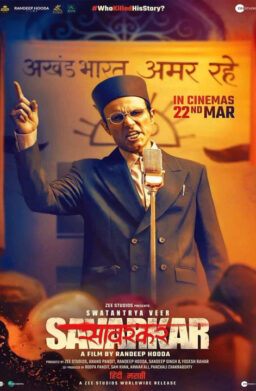I have always been fascinated by the life and legacy of Vinayak Damodar Savarkar, one of the most prominent and controversial figures of the Indian freedom struggle. Like most Indian kids of my vintage, my first brush with Veer Savarkar was from the eponymous Amar Chitra Katha comic. I was fascinated by the depiction of his daring escape from a British ship, his revolutionary activities in London, his imprisonment in the notorious Cellular Jail in the Andaman Islands, and his later involvement in the Hindu Mahasabha. I was amazed by his courage, his intellect, his patriotism, and his resilience. Later on, as I grew older and read more widely, I realized how much the history textbooks in Indian schools had distorted and downplayed his role in the independence movement, and how much they had glorified the Congress and Gandhi, who had a very different vision and strategy for the nation.
So, when the biopic on Savarkar starring Randeep Hooda in the lead role was released, I was very excited and curious to see how the film would portray his life and his ideology. I am glad to say that the cinematic portrayal didn’t disappoint me. The film Swatantrya Veer Savarkar is a masterpiece of cinematic art, a powerful and poignant tribute to a man who sacrificed everything for his motherland, and a must-watch for every Indian who wants to learn the true and diverse history of the freedom struggle.
The film covers the major events and phases of Savarkar’s life, from his childhood in Maharashtra, to his studies and activism in London, his arrest and deportation to the Andaman Islands, his release and participation in the Hindu Mahasabha, his trial and acquittal in the Gandhi assassination case, to his death in 1966. The film does not shy away from showing the controversies and criticisms that surrounded Savarkar, such as his petitions for clemency, his advocacy of Hindutva – “Hindutva is political, geographical, cultural and historical, not of any religion” – and his alleged involvement in the conspiracy to kill Gandhi. The film also highlights the contributions and sacrifices of his family, his comrades, and his fellow revolutionaries, many of whom have been shamefully forgotten by mainstream history.
This film is remarkable for its realism and authenticity. Savarkar, the film, raises some intriguing questions. Questions that have been on my mind for a long time about why none of the Congress leaders were ever sent to Kala Pani, and how only those who the British considered dangerous were banished there. So weren’t Gandhi and the other congressmen of the “naram dal” or the “moderates” faction, ever considered dangerous to the British Empire? Lokmanya Tilak was sent to Mandalay but no one else. Makes one think, doesn’t it? How exactly did the Morley-Minto reforms or the Quit India movement that petered out within a few months, or the Gandhi-Irwin pact – which we are taught in chapter after chapter in our history books – contribute to India’s freedom? One additional good that came out of the movie was the debunking of the oft-repeated claim that Savarkar was the original propagator of the two-nation theory.
The repeated gallows scenes of the young revolutionaries, who were hanged by the British for their involvement in various plots and conspiracies are truly haunting. So many young men who laid down their lives for our nation. An ungrateful nation that has forgotten their memories.
The portrayal of Gandhi raised a laugh, everytime the character appeared on the screen. Gandhiji’s espousal of ahimsa, and his repeated references to “ahimsa paramo dharamaha” elicit chuckles from the audience. I was waiting for Savarkar to complete that saying which goes “dharma himsa tathaiva cha” – violence in the cause of dharma is also acceptable, but sadly, that didn’t happen. Jawaharlal Nehru makes only very fleeting and caricatured appearances in the movie, which is alright, since Savarkar’s main ideological opponent was Gandhi and not Nehru.
Savarkar’s appalling treatment by Nehru, when the Pakistani prime minister visited India, by throwing him in jail for a further hundred days was shown towards the end of the movie. That such a great patriot had to undergo such indignities at this stage of his life, in a free country for whose independence he had spent his entire life, was a damning indictment of Nehru and everyone else associated with the Congress. Also, it wasn’t just Savarkar who suffered for his activities. His entire family went through hell – losing their wealth and possessions, having two sons end up in Cellular Jail, unable to earn a living, having the third son die as a result of the post-Gandhi-assassination violence unleashed on the hapless Chitpavan brahmins in Maharashtra. That they still managed to maintain their love for the nation is a tribute to their upbringing and values.
The film is a marvel of acting, direction, music, and script. Randeep Hooda delivers a stellar performance as Savarkar, capturing his personality, his emotions, his charisma, and his convictions. He becomes Savarkar on the screen, and makes us feel his pain, his passion, his pride, and his perseverance. The supporting cast is equally impressive, especially Ankita Lokhande as Savarkar’s wife, Amit Sial as his elder brother, Baburao and even Mrinal Dutt , who shines, in a small role as Madanlal Dhingra.
The music in Savarkar is unobtrusive and enhances the mood and the message of the film. None of the jarring, violin-heavy pieces that mar other Indian historicals. The dialogues pack a punch and convey the essence of Savarkar’s philosophy and vision. One of the most striking dialogues is uttered by a British officer, Craddock, who says that the reason he considers Savarkar the most dangerous man he has ever met is because in one meeting, he almost convinced him (Craddock) that the British were in the wrong!
Indian biopics tend to be hagiographic in general (and yes, I would consider even Gandhi an ‘Indian’ biopic and it is hagiographic). One could potentially lay the same charge at this movie as well. However, given how few movies depicting heroes other than from the Congress’ approved list of independence stalwarts have been made, the makers of the movie can be excused for wanting to show their side of the independence story.
Ultimately, Savarkar is a tribute to a forgotten hero, and a lesson in history. It is a film that every Indian should watch, to gain a deeper understanding of the freedom struggle, which was multi-layered and multi-hued, rather than the simplistic, Congress-dominated narrative that we have been taught. It is a film that will make you proud, angry, sad, and inspired. It is a film that will make you think, question, and appreciate the sacrifices and the struggles of those who fought for our freedom.
Disclaimer: The opinions expressed in this article belong to the author. Indic Today is neither responsible nor liable for the accuracy, completeness, suitability, or validity of any information in the article.








